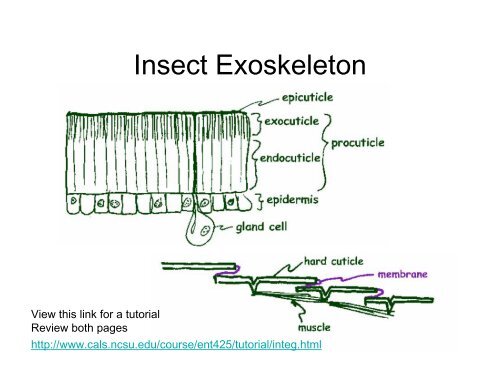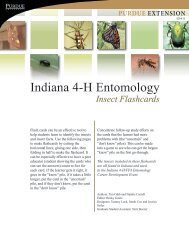Insect Exoskeleton - Purdue Extension Entomology
Insect Exoskeleton - Purdue Extension Entomology
Insect Exoskeleton - Purdue Extension Entomology
You also want an ePaper? Increase the reach of your titles
YUMPU automatically turns print PDFs into web optimized ePapers that Google loves.
<strong>Insect</strong> <strong>Exoskeleton</strong><br />
View this link for a tutorial<br />
Review both pages<br />
http://www.cals.ncsu.edu/course/ent425/tutorial/integ.html
Molting (Ecdysis)<br />
Shed<br />
Resorbed<br />
•Under control of growth hormones AKA insect growth regulators<br />
juvenile hormone and ecdysone).<br />
• Ratio of juvenile type to ecdysone type hormones moderates<br />
maturation process
How <strong>Insect</strong>s Jump Out of Their<br />
Skins<br />
• Apolysis – Air is blown to separate cuticle from<br />
epidermis<br />
• Chitinases and proteases secreted from<br />
endodermal glands dissolve endocuticle<br />
• Epidermal cells multiply and secrete new<br />
cuticle<br />
• Waxy layer secreted<br />
• Old insects cuticle splits along specialized<br />
wrinkles (ecdysial lines) and insect crawls out
Adult breaks through<br />
ecdysial suture in the<br />
insect exoskeleton<br />
Cicada Ecdysis
Cuticle Hardening<br />
• Newly molted exoskeletons are soft and<br />
light colored.<br />
• Exposure to air and other chemicals<br />
(tyrosine) produced by insect causes<br />
sclerotization (hardening) and later<br />
melanization (browning)<br />
• This can take several days
The Cicada Life Cycle<br />
http://www.bio.indiana.edu/~hangarterlab/broodx/broodxmovies/NSFmovie.htm
Kinds of Metamorphosis<br />
• Ametabolous<br />
– no metamarphosis<br />
• Hemimetabolous<br />
– Incomplete metamorphosis<br />
• Holometabolous<br />
– Complete metamorphos
Incomplete Metamorphosis<br />
ADULT<br />
EGG<br />
NYMPH<br />
NYMPH
Incomplete Metamorphosis<br />
• 3 <strong>Insect</strong> Stages<br />
– Eggs<br />
– Larvae<br />
• Body form resembles adult<br />
• No wings<br />
– Adults<br />
• No increase in size<br />
• Reproduction<br />
• Wings fully grown if present
Example: Squash Bug<br />
Adult<br />
Nymph 3<br />
Nymph 2<br />
Nymph 4
Do small butterflies<br />
grow up to be big butterflies?
Do small butterflies<br />
grow up to be big butterflies?<br />
No
Complete Metamorphosis<br />
• 4 <strong>Insect</strong> Stages<br />
– Eggs<br />
– Larvae<br />
– Pupae<br />
• Transformation from larva to adult<br />
• True legs, wings, antennae are formed<br />
– Adults<br />
• No increase in size<br />
• Reproduction<br />
• Short Life span
Complete Metamorphosis (fly)<br />
ADULT<br />
EGG<br />
PUPA<br />
LARVA
Adult and immature insects with<br />
complete metamorphosis feed on the<br />
different food<br />
egg 1st 2nd 3rd pupa adult<br />
instar larva
<strong>Insect</strong> Characteristics<br />
• Three body regions<br />
• 3 pairs of legs<br />
• Adults usually have 2 pairs of wings
<strong>Insect</strong>s<br />
• 3 Distinct body regions<br />
– Abdomen<br />
– Thorax<br />
– Head<br />
**EXOSKELETON**
The <strong>Insect</strong> Body<br />
head<br />
thorax<br />
abdomen
Head<br />
(Perception and Ingestion)<br />
•1 Pair of antennae<br />
• 1 Pair of compound eyes<br />
• Ocelli<br />
•**Mouthparts
Lubber Grasshopper Head with Dissected Mouth<br />
antenna<br />
compound eye<br />
ocelli<br />
frons<br />
clypeus<br />
mandible<br />
maxilla<br />
<br />
<br />
labrum<br />
labium<br />
Function of Head?
The <strong>Insect</strong> Head - Frontal
Compound<br />
eye
Mouthpart Orientation<br />
Hypognathous<br />
Hypognathous (Ventral) – Many herbivores
Modifications of Chewing<br />
Mouthparts<br />
Elongate rostrum of chewing insect<br />
Hollyhock weevil<br />
Chewing mouthparts of yellow jacket<br />
Wasp
Mouthpart Orientation<br />
Prognathous (Anterior) – Many Predators
Mouthpart Orientation<br />
Opistognathous<br />
Hinged toward posterior (predator)<br />
Fixed toward posterior (herbivore)
Piercing Sucking
Piercing-Sucking Mouthparts<br />
eyes<br />
antenna<br />
Leg 1<br />
Leg 2<br />
Leg 3
Diptera – Fly Mouth<br />
Mosquitoes<br />
Horsefly
Lepidoptera - Butterflies<br />
and Moths
Modifications of the Antenna<br />
Scape<br />
Pedicel<br />
Flagellum<br />
http://www.cals.ncsu.edu/course/ent425/tutorial/antenna.html
Filiform Antennae
Capitate antennae
Geninculate (bent) antennae<br />
Weevil<br />
Wasp
Lamellate Antenna of Scarab<br />
Beetle
Plumose Plumose Antennae<br />
antennae

















